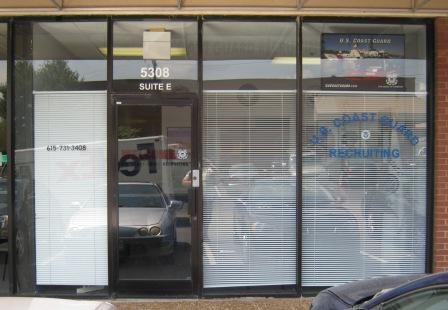Window signs create another avenue for businesses to communicate their marketing message, their brand, or to advertise a special offer (and they can really make your storefront look great!).
Some materials used for window graphics are opaque or somewhat translucent, allowing light to pass but offering no visibility. For purposes related to lighting as well as safety and convenience, there are also digitally printable window sign materials that are perforated with small holes. The unprinted side of the window vinyl is typically black. When these perforated materials are applied to window glass, they create a one-way viewing capability. During daylight conditions, individuals inside the building can see through the window film to the outside. Passersby (potential customers!) get to see the great graphics on the window film, but they can't see well through the glass into the business.
 This US Coast Guard office got a "facelift" with replacement of the location's old signage with new, full coverage window graphics fabricated with the perforated window film. We'll be interested to see if the number of recruits goes up now that this location is more visible!
This US Coast Guard office got a "facelift" with replacement of the location's old signage with new, full coverage window graphics fabricated with the perforated window film. We'll be interested to see if the number of recruits goes up now that this location is more visible!

The percent of open area in these perforated materials can vary from 35-50%. For vehicle window signs, we recommend the 50% open type of perforated window film for best visibility (and it's usually required by law for vehicles). Window graphics using a 30-35% open area have a larger surface area for the full color printed graphics, which results in more "pop" in the graphics relative to those films with larger open areas.
Some municipalities require that window graphics and signage be on the inside surface of the glass. This requires a different set of sign materials and takes away some of the color vibrance available with outside graphics, but the window signs can still be effective and eye catching.
Full color window graphics such these, whether for vehicle signage or commercial signage, are fabricated with digital printing on a large format printer. The graphics are protected with an optically clear overlaminate that also helps to slow the fading process from UV exposure.


Leave a Reply